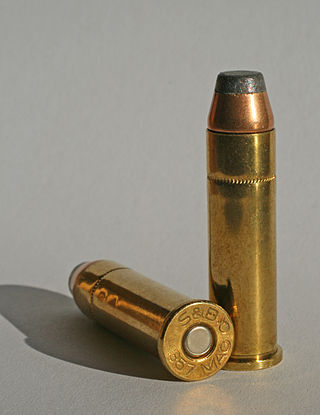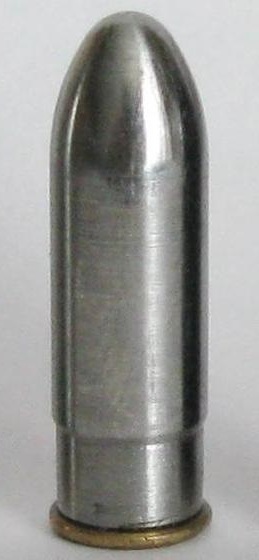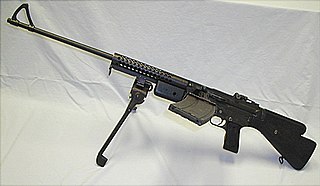
A firearm is any type of gun that uses an explosive charge and is designed to be readily carried and operated by an individual. The term is legally defined further in different countries.

A cartridge, also known as a round, is a type of pre-assembled firearm ammunition packaging a projectile, a propellant substance and an ignition device (primer) within a metallic, paper, or plastic case that is precisely made to fit within the barrel chamber of a breechloading gun, for convenient transportation and handling during shooting. Although in popular usage the term "bullet" is often used to refer to a complete cartridge, the correct usage only refers to the projectile.
A muzzleloader is any firearm in which the user loads the projectile and the propellant charge into the muzzle end of the gun. This is distinct from the modern designs of breech-loading firearms, in which user loads the ammunition into the breech end of the barrel. The term "muzzleloader" applies to both rifled and smoothbore type muzzleloaders, and may also refer to the marksman who specializes in the shooting of such firearms. The firing methods, paraphernalia and mechanism further divide both categories as do caliber.

A centre-fire is a type of metallic cartridge used in firearms, where the primer is located at the center of the base of its casing. Unlike rimfire cartridges, the centerfire primer is typically a separate component seated into a recessed cavity in the case head and is replaceable by reloading the cartridge.

The Heckler & Koch G11 is a non-production prototype assault rifle developed from the late 1960s to the 1980s by Gesellschaft für Hülsenlose Gewehrsysteme (GSHG), a conglomeration of companies headed by firearm manufacturer Heckler & Koch, Dynamit Nobel, and Hensoldt Wetzlar. The rifle is noted for its use of caseless ammunition.

A rim-fire is a type of metallic cartridge used in firearms where the primer is located within a hollow circumferential rim protruding from the base of its casing. When fired, the gun's firing pin will strike and crush the rim against the edge of the barrel breech, sparking the primer compound within the rim, and in turn ignite the propellant within the case. Invented in 1845 by Louis-Nicolas Flobert, the first rimfire metallic cartridge was the .22 BB Cap cartridge, which consisted of a percussion cap with a bullet attached to the top. While many other different cartridge priming methods have been tried since the early 19th century, such as teat-fire and pinfire, only small caliber rimfire cartridges have survived to the present day with regular use. The .22 Long Rifle rimfire cartridge, introduced in 1887, is by far the most common ammunition found in the world today in terms of units manufactured and sold.

Caseless ammunition (CL), or caseless cartridge, is a configuration of weapon-cartridge that eliminates the cartridge case that typically holds the primer, propellant and projectile together as a unit. Instead, the propellant and primer are fitted to the projectile in another way so that a cartridge case is not needed, for example inside or outside the projectile depending on configuration.

A sabot is a supportive device used in firearm/artillery ammunitions to fit/patch around a projectile, such as a bullet/slug or a flechette-like projectile, and keep it aligned in the center of the barrel when fired. It allows a narrower projectile with high sectional density to be fired through a barrel of much larger bore diameter with maximal accelerative transfer of kinetic energy. After leaving the muzzle, the sabot typically separates from the projectile in flight, diverting only a very small portion of the overall kinetic energy.
Internal ballistics, a subfield of ballistics, is the study of the propulsion of a projectile.

A magazine, often simply called a mag, is an ammunition storage and feeding device for a repeating firearm, either integral within the gun or externally attached. The magazine functions by holding several cartridges within itself and sequentially pushing each one into a position where it may be readily loaded into the barrel chamber by the firearm's moving action. The detachable magazine is sometimes colloquially referred to as a "clip", although this is technically inaccurate since a clip is actually an accessory device used to help load ammunition into a magazine or cylinder.
The Winchester Repeating Arms Company was a prominent American manufacturer of repeating firearms and ammunition. The firm was established in 1866 by Oliver Winchester and was located in New Haven, Connecticut. The firm went into receivership in 1931 and was bought by the Western Cartridge Company, a forerunner of the Olin Corporation. The Winchester brand name is still owned by the Olin Corporation, which makes ammunition under that name. The Winchester name is also used under license for firearms produced by two subsidiaries of the Herstal Group – FN Herstal of Belgium and the Browning Arms Company of Ogden, Utah.

The M1941 Johnson Light Machine Gun, also known as the Johnson and the Johnny gun, was an American recoil-operated light machine gun designed by Melvin Johnson in the late 1930s. It shared the same operating principle and many parts with Malvin's M1941 Johnson rifle and M1947 Johnson auto carbine.

The 7.92×57mm Mauser is a rimless bottlenecked rifle cartridge. The 7.92×57mm Mauser cartridge was adopted by the German Empire in 1903–1905, and was the German service cartridge in both World Wars. In its prime, the 7.92×57mm Mauser cartridge was one of the world's most popular military cartridges. In the 21st century it is still a popular sport and hunting cartridge that is factory-produced in Europe and the United States.

Daisy Outdoor Products is an American airgun manufacturer known particularly for their lines of BB guns. It was formed in 1882 initially as the Plymouth Iron Windmill Company in Plymouth, Michigan, to manufacture steel windmills, and from 1888 started bundling BB-caliber air guns with each windmill purchase as a sales promotion. With the unrivaled popularity of their 1888-model Daisy BB Guns, the company changed the name to Daisy Manufacturing Company in 1895 and switched their business to solely producing air guns for sale. Throughout the 20th century, Daisy has been known as a company that makes and sells BB guns and pellet youth rifles. Their Red Ryder BB Gun is perhaps the best known and longest production item, which has been featured in many TV shows and movies since its introduction in the spring of 1940.
The Voere VEC-91 is a rifle made by Voere and was the first commercial sporting rifle to combine caseless ammunition and electronic firing. Depending on the cartridge that was chambered for, it could fire either a 5.56 millimetres (0.219 in), 5.7 millimetres (0.22 in), or 6 millimetres (0.24 in) projectile at muzzle velocities at up to 930 metres per second (3,100 ft/s). The rifle was first exported to the United States in 1993, but was not a commercial success.
The following are terms related to firearms and ammunition topics.
The Lightweight Small Arms Technologies (LSAT) program is funded by the U.S. Joint Service Small Arms Program, with the goal of significantly reducing the weight of small arms and their ammunition. Following a series of military programs to investigate advances in small arms, the LSAT program is the US military's latest project to replace existing US small arms. Tactical concepts and the research from the previous small arms programs indicates that lightening small arms is the first significant step towards increasing soldiers' lethality and survivability.

Ammunition is the material fired, scattered, dropped, or detonated from any weapon or weapon system. Ammunition is both expendable weapons and the component parts of other weapons that create the effect on a target.

In firearms and artillery, the primer is the chemical and/or device responsible for initiating the propellant combustion that will propel the projectiles out of the gun barrel.

Ball propellant is a form of nitrocellulose used in small arms cartridges. Ball propellant can be manufactured more rapidly with greater safety and less expense than extruded propellants.













